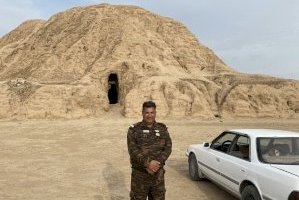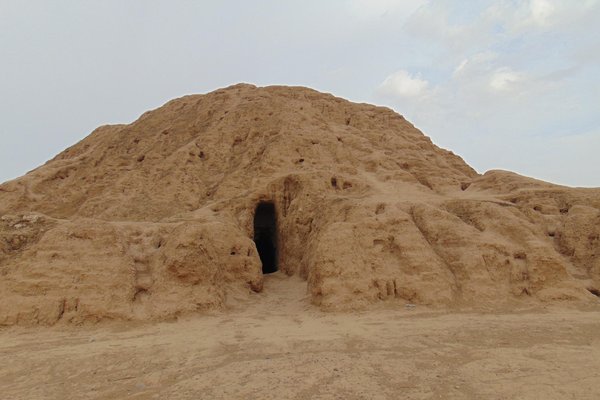Iraq
Ashur
Ashur (Qal'at Sherqat) comprises the remains of the first capital of the Assyrian Empire.
The city was the centre for worship of the god Ashur and the goddess Ishtar/Inanna. Ashur contained many important religious buildings and a handful of palaces. They show the evolution of the building practice from the Sumerian to the Parthian periods.
Community Perspective: Located near Mosul, it has been off-limits for decades. Thomas managed to visit in 2021 – the site hasn’t seen as much war damage as other Iraqi sites, but not much has been excavated. Clyde went in 2024 and highlighted the site's history.
Site Info
Official Information
- Full Name
- Ashur (Qal'at Sherqat) (ID: 1130)
- Country
- Iraq
- Status
-
Inscribed 2003
Site history
History of Ashur
- 2003: In Danger
- Dam proposal; state of war in the country
- 2003: Inscribed
- Inscribed
- In Danger
- Dam proposal; state of war in the country Since 2003
- Type
- Cultural
- Criteria
- iii
- iv
Links
- UNESCO
- whc.unesco.org
- Official
-
- assur.de — History & Excavations
All Links
UNESCO.org
- whc.unesco.org — whc.unesco.org/
Official Website
- assur.de — History & Excavations
News Article
- June 21, 2022 theartnewspaper.com — New dam could drown ancient Iraqi city of Ashur
- Jan. 5, 2022 smithsonianmag.com — At the Iraqi Site of Assur, Ancient History Stands at Risk of Destruction
Community Information
- Community Category
- Archaeological site: Near Eastern
Travel Information
One thousand visitors or fewer
Red Zone Travel Advisory
Recent Connections
-
Perfect Inscriptions
2003 -
Red Zone Travel Advisory
All of Iraq except Kurdistan -
Tigris - Euphrates Basin
West bank of the Tigris River
Connections of Ashur
- Individual People
-
-
Gertrude Bell
Photo taken April 1909
-
- Geography
-
-
Under control of ISIS
Since March 7, 2015, the city was in ISIL held territory; As of February 2017, the group no longer controls the site, however it is not secure enough for archaeological experts to evaluate (wiki) -
Tigris - Euphrates Basin
West bank of the Tigris River
-
- Trivia
-
-
In the Pergamon museum
Several reliefs and a "Cultic water basin" (measuring 3mx1m)See www.auaf.us
-
- History
-
-
Seleucid Empire
"The site survived the fall of the Assyrian empire in the 7th century BCE, and it flourished in the Hellenistic and Parthian periods until the 2nd century CE." (AB ev) -
Babylonian Empire
"Hammurabi, the Amorite king of Babylon conquered and incorporated the city into the First Babylonian dynasty empire following the death of Ishme-Dagan I around 1756 BC, while the next three Assyrian kings were viewed as vassals of Babylon." (wiki)See en.wikipedia.org
-
Excavated by the Deutsche Orient-Gesellschaft
Walter Andrae led DOG excavations at Assyrian capital of Assur from 1903 to 1914 (wiki) -
Assyrian Empire
"Its most important role was from the 14th to 9th century BC when it was the first capital of the Assyrian empire, the religious capital of Assyrians, and the place for crowning and burial of its kings." (OUV crit iii) -
Located in a Former Capital
First capital of ancient Assyrian Empire -
Mesopotamia
The ancient city of Ashur is located on the Tigris River in northern Mesopotamia. (AB ev) -
Oldest Buildings
Temple of Ishtar 2600BC "The city was occupied from the mid-3rd millennium BC (Circa 2600-2500 BC) to the 14th Century AD" (Wiki). " Early Dynastic period (first half of the third millennium B.C.). Some remains may even date to preceding periods. For this early part the stratigraphic excavation of the temple of Ishtar provided substantial information about the development of the religious architecture. Two of the five major building stages of it belong to this period." (Nom file) "The earliest traces of settlement in Ashur can be found in layer H of the Ishtar temple, but also in the oldest layers beneath the Old Palace, dating to the late Early Dynastic period (in the middle of the 3rd millennium B.C.). In the following Akkadian period (ca. 2340-2200 B.C.) which is represented by layer G of the Ishtar temple, Ashur is under the rule of the kings of Akkad. During the time of the 3rd Dynasty of Ur (ca. 2100-2000 B.C.) a governor of this dynasty is attested in Ashur." (Assur.de) -
Parthian Empire
short revival during the Parthian period, "More than 1,000 inhumations in graves and tombs from the Parthian period, mainly located inside the buildings, provide important information on aspects of burial rites and funerary culture. The Parthian palace and a temple close to the ziggurat are architectural testimonies of this period. "(OUV) -
Eunuchs
See www.ucl.ac.uk
-
Akkadian Empire
"buildings of Ashur provide an outstanding record of the evolution of building practice from the Sumerian and Akkadian period through the Assyrian empire" (Crit iv OUV)
-
- Architecture
-
-
Earth Architecture
"The majority of the buildings of the city were built with sun-dried mud-bricks" (AB ev)
-
- Damaged
-
-
'Threatened' by Dams
Makhool Dam (now cancelled) -
Destroyed during invasion
Destroyed by the Medes in 614 BC
-
- World Heritage Process
-
-
Perfect Inscriptions
2003 -
Directly in Danger
Emergency Inscription
-
- Religion and Belief
-
-
Goddesses
centre for worship of the goddess Ishtar -
Mentioned in the Bible
Asshur, a city characterized by the mounds of Kalah Sherghat, on the west bank of the Tigris (Genesis 2:14)
-
- Human Activity
-
-
Writing systems
Source of more than 16000 cuneiform tablets
-
- Constructions
-
-
Tombs
"the more than 1,000 inhumations in graves and tombs, mainly located inside the buildings, which provide important information on aspects of burial rites and funerary culture." (AB ev) -
Ziggurat
"The major features of the city which are presently visible on-site consist of architectural remains (some of them partly restored): the ziggurat and the great temple of the god Ashur, the double-temple of Anu and Adad (with the remains of two smaller ziggurats)" (AB eval) -
Tell
"an exceptional testimony to succeeding civilizations from the Sumerian period in the 3rd millennium BC to the Assyrian empire from the 14th to 9th centuries, and, later, the Parthian revival in the 2nd century BC" (OUV), has mounds with layers from different civilizations (see link)See www.assur.de
-
- WHS on Other Lists
-
-
Global Heritage Fund
Threat level: rescue needed
-
- Timeline
-
-
Built in the 2nd Millennium BC
"the most important role of Ashur was from the 14th to 9th century BCE when it was the first capital of the Assyrian empire" (AB ev)
-
- Visiting conditions
-
-
One thousand visitors or fewer
“There are ca 1,000 visitors per year.” (AB ev) -
Red Zone Travel Advisory
All of Iraq except Kurdistan
-
- WHS Names
-
-
Untranslated Toponyms
Ashur (Qal'at Sherqat): Qalat or kalata (قلعه) in Persian, and qal'a(-t) or qil'a(-t) (قلعہ, قلعة) in Arabic, means 'fortress', 'fortification', 'castle',[ or simply 'fortified place'.See en.wikipedia.org
-
News
- theartnewspaper.com 06/21/2022
- New dam could drown ancient Iraqi …
- smithsonianmag.com 01/05/2022
- At the Iraqi Site of Assur, Ancien…
Community Reviews
Show full reviews
I visited this WHS in September 2024 as a long day trip together with Hatra. An early start to the day and a reputable fixer/tour agency with good contacts is essential to allow for the several military checkpoints and to make sure everything goes smoothly. Even though eventually everything went very smoothly and I made it in time for both WHS, I wouldn't have made it without an early start.
Ashur was the capital of the Old Assyrian city-state (2025–1364 BC), the Middle Assyrian Empire (1363–912 BC), and for a time, of the Neo-Assyrian Empire (911–609 BC). The remains of the city lie on the western bank of the Tigris River, north of the confluence with its tributary, the Little Zab. Unlike Babylon, almost no reconstructions remain or were made. From Ashur onwards, the effects of the conflicts and the tensions and destruction they brought with them are clearly visible. Upon arrival, you'll immediately notice the several bullet holes in the makeshift UNESCO WHS signs.
The oldest remains of the city were discovered in the foundations of the Ishtar temple, as well as at the ruins of the Old Palace. During the Akkadian Empire (around 2334-2154 BC), Ashur was a provincial capital led by a vassal of the Akkadian kings. During the 3rd Dynasty of Ur (around 2112-2004 BC), Ashur continued as a governorate subject to the Sumerians. By the time the Neo-Sumerian Ur dynasty collapsed at the hands of the Elamites around the end of the 21st …
Keep reading 0 comments
Ashur (Assur) was the first Assyrian capital and remained so for a long period (1400 to 608 BC). Located on the western banks of the Tigris River, just a bit north of the confluence with the Lesser Zab river, it became an important trading and religious centre with a large ziggurat. The city lies about 140km south of Mosul, and we visited the place on the first day of November 2021, coming from Baghdad on our way to Mosul. Our guide Hayder did his homework. The chief of security at this important archaeological site gave us an entry permit on the spot, and we were even driven around the premises in his private car. Here excavations have been done predominantly by German archaeologists, starting as early as 1903, about 4 years after Babylon. Not surprisingly that many of Ashur's artefacts and statues are kept safe far away, in Berlin's Pergamon Museum, some are in the Archaeological Museum in Istanbul. Good in that case, since the nearby Mosul Museum has suffered severe damage to its collections. Ashur was not destroyed by the ISIS extremists on the same magnitude as Nimrud, Hatra or Mosul/Nineveh, simply because only a few palaces and temples (10 out of 34) are fully excavated. But another threat comes from the Makhul Dam project, an ambitious plan of the Iraqi government, creating a 20 mile-long lake, most likely partially flooding the ancient city of Ashur. After a long pause due to the Gulf war, and political turmoil, construction …
Keep reading 0 comments
